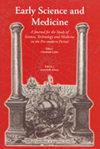气候与气质:13、14世纪气候与环境对人类肤色的影响
IF 0.2
2区 哲学
Q3 HISTORY & PHILOSOPHY OF SCIENCE
引用次数: 0
摘要
本论文从自然哲学的观点论述了当地条件——地理的、生物的或占星的条件——被认为是如何影响人性的一般构成的。构成民族和个人之间差异的物质条件是什么?本文的重点是研究气候带与居民肤色之间的关系。这种关系和随之而来的自然决定论在阿尔伯特大帝的《自然轨迹》中都有体现。虽然托马斯·阿奎那没有像阿尔伯特那样详细地阐述人种学的细节,但他分享了他的老师提出的总体框架,即占星和地理条件极大地影响了居民的肤色。约翰·布里丹在他对亚里士多德的《自然形态》的未经编辑的评论中,坚持了亚里士多德的一般范式,阿尔伯特和托马斯也坚持了这一范式,但更详细地考虑了气候条件对个体人类肤色的影响。本文章由计算机程序翻译,如有差异,请以英文原文为准。
Climata et temperamenta: the Influence of Climate and Environment on Human Complexion in the Thirteenth and Fourteenth Centuries
The present paper addresses the way in which local conditions – geographical, biological or astrological – were believed to influence the general constitution of human nature from the viewpoint of natural philosophy. What were the material conditions that constituted the diversity between peoples and individuals? The focus of this paper is on the relation between climatic zones and the complexion of their inhabitants. This relation and the ensuing natural determinism are present in Albert the Great’s De natura loci . While not being as specific as Albert in laying out the ethnographic specifics, Thomas Aquinas shared the general framework set out by his teacher that astrological and geographical conditions greatly affect the complexion of the inhabitants. In his unedited commentary on Aristotle’s Parva naturalia , John Buridan sticks to the general Aristotelian paradigm, to which Albert and Thomas also adhered, but considers in greater detail the way climatic conditions affect the individual human complexion.
求助全文
通过发布文献求助,成功后即可免费获取论文全文。
去求助
来源期刊

Early Science and Medicine
HISTORY & PHILOSOPHY OF SCIENCE-
CiteScore
0.50
自引率
0.00%
发文量
22
审稿时长
>12 weeks
期刊介绍:
Early Science and Medicine (ESM) is a peer-reviewed international journal dedicated to the history of science, medicine and technology from the earliest times through to the end of the eighteenth century. The need to treat in a single journal all aspects of scientific activity and thought to the eighteenth century is due to two factors: to the continued importance of ancient sources throughout the Middle Ages and the early modern period, and to the comparably low degree of specialization and the high degree of disciplinary interdependence characterizing the period before the professionalization of science.
 求助内容:
求助内容: 应助结果提醒方式:
应助结果提醒方式:


